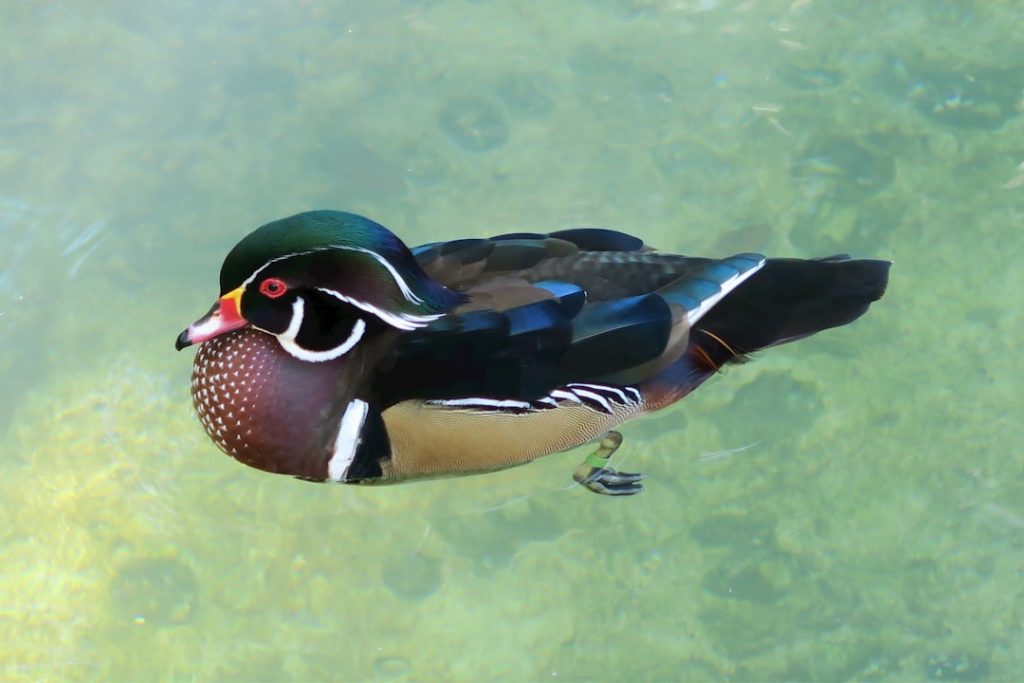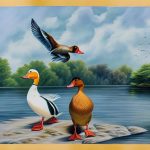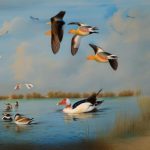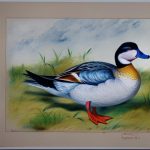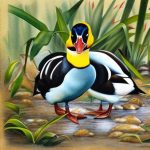Mallard ducks are one of the most common and recognizable duck species in North America. They are known for their striking iridescent green heads, white neck ring, and chestnut-brown chest. Mallards are also popular game birds and are often found in wetlands, ponds, and rivers. Breeding season for mallard ducks typically begins in the early spring, with courtship displays and pair bonding taking place before nesting begins. Mallard ducks are monogamous during the breeding season, with pairs forming strong bonds that can last for the duration of the breeding season.
During the breeding season, male mallards will perform elaborate courtship displays to attract a mate. These displays often involve the male bobbing his head, flapping his wings, and making a series of soft calls to the female. Once a pair has formed, they will begin to search for a suitable nesting site. Mallard ducks are known for nesting in a variety of habitats, including grassy areas near water, marshes, and even urban environments. The female will construct the nest using grasses, reeds, and other plant materials, creating a shallow depression lined with down feathers for insulation. Once the nest is complete, the female will begin laying eggs, typically laying one egg per day until she has a clutch of 8-13 eggs.
Table of Contents
Key Takeaways
- Mallard ducks are a common and widespread species of duck found throughout North America, Europe, and Asia.
- Female mallard ducks build their nests on the ground, often near water, and lay an average of 8-13 eggs.
- The incubation period for mallard duck eggs is around 27-28 days, during which the female will sit on the nest to keep the eggs warm.
- Mallard ducklings are precocial, meaning they are able to feed themselves and follow their mother shortly after hatching.
- Mallard ducks face threats to their breeding habitats from habitat loss, pollution, and hunting, making conservation efforts crucial for their survival.
Nesting and Egg Laying
Mallard ducks are known for their adaptability when it comes to nesting sites. They will nest in a variety of locations, including marshes, grasslands, and even urban areas. The female mallard will typically choose a nesting site that provides good cover and protection from predators, such as tall grass or reeds near water. The female will construct the nest by creating a shallow depression in the ground and lining it with down feathers plucked from her own breast. This down lining provides insulation and helps to keep the eggs warm during incubation.
Once the nest is complete, the female will begin laying eggs, typically laying one egg per day until she has a clutch of 8-13 eggs. The eggs are a pale green or blue color and are about the size of a large chicken egg. The female will continue to lay eggs until she has a full clutch, at which point she will begin incubating them. During this time, the male will often stand guard nearby to protect the female and the nest from potential predators. The female will only leave the nest briefly to feed and bathe, returning quickly to keep the eggs warm and protected.
Incubation Period
After the female mallard has laid her full clutch of eggs, she will begin the incubation process. Incubation typically lasts for about 26-28 days, during which time the female will sit on the eggs to keep them warm and protected. The down feathers lining the nest provide insulation and help to regulate the temperature of the eggs during this time. The female will turn the eggs regularly to ensure that they develop properly and receive even heat distribution.
During this time, the male mallard will continue to stand guard nearby, keeping watch for potential predators and alerting the female to any potential threats. The male may also bring food to the female during this time to help sustain her during the incubation period. The female will only leave the nest briefly to feed and bathe, returning quickly to continue her incubation duties. As the incubation period progresses, the female will become more protective of her nest and may become more aggressive towards potential threats.
Hatching and Duckling Care
After about 26-28 days of incubation, the eggs will begin to hatch. The ducklings use their egg tooth, a small projection on their bill, to break through the shell. Once hatched, the ducklings are covered in down feathers and are able to leave the nest within hours of hatching. The female will lead her brood to water shortly after hatching, where the ducklings will begin to feed on insects, small crustaceans, and plant matter.
The female mallard will continue to care for her ducklings after they hatch, leading them to suitable feeding areas and protecting them from potential predators. The male may also play a role in caring for the ducklings, providing protection and guidance as they begin to explore their surroundings. Mallard ducklings grow quickly and are able to fly within 2 months of hatching.
Fledging and Growth
Mallard ducklings grow rapidly in their first few weeks of life. They are able to leave the nest within hours of hatching and are able to feed themselves on insects, small crustaceans, and plant matter. The female mallard will lead her brood to suitable feeding areas near water, where the ducklings can find food and learn important foraging skills.
As the ducklings grow, they will begin to develop their flight feathers and will start practicing short flights around their habitat. By about 2 months of age, mallard ducklings are fully fledged and able to fly. At this point, they will begin to explore their surroundings more independently and may start to disperse from their natal area.
Mating and Pair Bonding

Mallard ducks are monogamous during the breeding season, with pairs forming strong bonds that can last for the duration of the breeding season. Courtship displays play an important role in pair bonding for mallard ducks. Male mallards perform elaborate displays to attract a mate, including head bobbing, wing flapping, and soft calls. Once a pair has formed, they will engage in mutual preening and other bonding behaviors.
During the breeding season, mallard pairs will work together to find a suitable nesting site and raise their brood of ducklings. The male may play a role in protecting the female and their offspring from potential threats, as well as providing food for the female during incubation. After the breeding season is over, mallard pairs may go their separate ways until the next breeding season begins.
Conservation and Threats to Mallard Duck Breeding
Mallard ducks are one of the most common and widespread duck species in North America. However, they still face a number of threats that can impact their breeding success. Habitat loss is a major threat to mallard ducks, as wetlands and other important breeding habitats are destroyed or degraded by human development. Pollution and water quality issues can also impact mallard breeding success, as contaminants in waterways can affect egg viability and duckling survival.
Predation is another significant threat to mallard duck breeding success. Nest predation by mammals such as raccoons and skunks can significantly impact nesting success for mallard ducks. Additionally, predation on ducklings by birds of prey and other predators can impact overall breeding success for mallard ducks.
Conservation efforts aimed at protecting wetland habitats and improving water quality can help support mallard duck breeding success. Creating protected areas for nesting and providing predator control measures can also help support mallard populations. By addressing these threats and implementing conservation measures, we can help ensure that mallard ducks continue to thrive in their natural habitats for generations to come.
If you’re interested in learning more about the breeding cycle of mallard ducks, you might also find our article on converting a shed into a chicken coop helpful. Understanding the needs of different poultry species can provide valuable insights into creating suitable environments for them to thrive. Check out our article on converting a shed into a chicken coop to discover how to repurpose existing structures to accommodate various types of poultry.
FAQs
What is the breeding cycle of mallard ducks?
The breeding cycle of mallard ducks typically begins in the spring, when the males perform courtship displays to attract females. Once a female chooses a mate, they will build a nest together.
Where do mallard ducks build their nests?
Mallard ducks typically build their nests on the ground, often near water. They prefer to nest in areas with tall grass or other vegetation to provide cover and protection for their eggs.
How many eggs do mallard ducks lay?
Mallard ducks typically lay around 8-13 eggs in a single clutch, although the number can vary. The female will then incubate the eggs for about 27-28 days until they hatch.
What happens after the eggs hatch?
After the eggs hatch, the female leads the ducklings to water, where they will learn to swim and forage for food. The male may also provide protection for the ducklings during this time.
How long does it take for mallard ducklings to mature?
Mallard ducklings mature quickly and are able to fly within 2 months of hatching. They will then leave their parents and join other ducks in flocks.
Meet Walter, the feathered-friend fanatic of Florida! Nestled in the sunshine state, Walter struts through life with his feathered companions, clucking his way to happiness. With a coop that’s fancier than a five-star hotel, he’s the Don Juan of the chicken world. When he’s not teaching his hens to do the cha-cha, you’ll find him in a heated debate with his prized rooster, Sir Clucks-a-Lot. Walter’s poultry passion is no yolk; he’s the sunny-side-up guy you never knew you needed in your flock of friends!

